Churn management is essential for sustainable business growth. It focuses on churn prevention by identifying why customers leave and taking action to retain them. With the right churn management strategy, companies can reduce customer loss, increase loyalty, and boost long-term revenue.
Good churn management often contributes more to a company’s growth than new customer acquisition. Churn refers to the loss of existing customers. If you succeed in retaining existing customers and increasing sales with them, revenue often grows more than it would through new customer acquisition.
Definition: What is churn management?
Churn management refers to the attempt to avoid customer churn. This mainly affects industries in which customers are tied to a company for a certain period of time due to contractual obligations and could switch providers after that period has expired. This is especially relevant for all products sold by subscription, from cell phone contracts to software-as-a-service products on the internet.
Churn rate and churn score in churn management
What is a churn score?
The churn score indicates the likelihood of a customer leaving the company. Companies can identify at-risk customers and take targeted action by analyzing customer behavior and characteristics.
There is no general definition for the churn score, as it varies from product to product. The following data can be used for the calculation:
- How long has it been since the customer last used the product?
- How often does the customer use the most relevant product function?
Example:
A cell phone contract has unlimited call minutes, whose main advantage over the competition is the phone features.
Churn score for the last use: The score increases by 1 point every day the cell phone is not logged into the network.
Churn score for the last phone call: The score increases by 10 points for every day that the phone is not used.
A user who has not turned on their phone for 3 days and has not made a phone call in 10 days has a churn score of 3×1 + 10×10 = 103.
If you calculate the current churn score for all users, you can set thresholds for when users need to be actively addressed to prevent churn.
Churn score at Riddle
At Riddle, we calculate the churn score as follows:
Each customer is assigned a churn score, which indicates how likely the customer will cancel their subscription.
The deviation from the Riddle-wide average (= benchmark) is calculated for the following metrics to calculate the churn score. The metrics apply to the entire account (across all projects):
- Total Riddles created (weight: 10%)
- Riddles published in the last 30 days (weighting: 20%)
- Views in the last 30 days (weighting: 20%)
- Leads in the last 30 days (weighting: 10%)
- Number of places added (weighting: 10%)
- Days since the last login (weighting: 10%)
- Views of the cancellation page (weighting: 20% – can only count negatively)
The churn score and benchmark metrics are calculated daily.
The churn score ranges from -80% to 100%, with 100% being the highest number (highest churn probability)
How do you calculate the churn rate?
The churn rate indicates the percentage of customers who have left the company in a given period. It is calculated by dividing the number of lost customers by the total number of customers at the beginning of the period and multiplying it by 100.
Example:
At the beginning of the month, the company has 3,200 customers. Of these, 15 cancel their subscription. The churn rate is 15/3,200 * 100 = 0.469%. New customers are not included in the calculation, so the number of active customers at the end of the period is irrelevant to the churn rate.
Why is churn management critical?
Customer acquisition is often more expensive than customer retention. Effective churn management reduces costs, strengthens the company’s image, and promotes long-term customer relationships.
The effect that churn management has on sales is best seen in a calculation example.
A company that sells a subscription product for €10/month and currently has 5,000 customers suffers from a 5% churn rate. Every year, 5% of existing customers cancel their subscriptions.
If the company now manages to reduce the churn rate, this has the following effects:
1. Short term (1 year)
A 1% reduction in the churn rate increases annual revenue by approximately €6,000. Fewer customers churn, and thus, more paying subscribers are retained over the year.
2. Medium term (5 years)
The effect grows significantly over five years. Reducing the churn rate from 5% to 4% leads to additional revenue of approximately €25,000** over this period. If the churn rate is reduced to 3%, revenue increases by a further €26,000** to around €515,000**. The difference between a churn rate of 5% and 1% is already over €100,000 in additional revenue.
3. Long term (10 years)
The effect is even more significant over a period of 10 years. Reducing the churn rate from 5% to 4% means an additional revenue of almost €40,000. If the churn rate is further reduced to 3%, 2%, or even 1%, the cumulative revenue increases by over €180,000** as customers stay in the system longer and continue to pay.
Summary:
While the short-term impact is still relatively small, the effects add up considerably over several years. This shows that customer retention measures – whether through better support, valuable product updates, or an improved customer experience – can have an immense long-term effect on a company’s revenue.
Reasons for customer churn
Voluntary churn
Voluntary churn occurs when customers change providers of their own accord, for example, because of better offers from the competition or dissatisfaction with the current service. Regular customer satisfaction surveys can counteract voluntary churn. A Net Promoter Score® (or NPS®) survey is best for this. A drop in the NPS value indicates increased customer dissatisfaction. If this is recognized in time, you can actively counteract it and prevent voluntary churn.
Involuntary churn
Involuntary churn occurs when customers can no longer use the service due to circumstances beyond their control, such as financial difficulties or relocation. The most common reason for involuntary churn is expired or blocked credit cards. A good subscription billing tool can help here by notifying customers in good time when a credit card is about to expire.
Another common reason for involuntary churn is insufficient funds on the credit card. Many companies use credit cards with small limits or pre-paid cards for security reasons. In this case, the billing tool must be able to try debiting over a longer period of time repeatedly.
Areas of application for churn management
Software-as-a-Service (SaaS) companies
SaaS companies depend on customers taking out subscriptions and remaining customers for as long as possible. Acquiring a new customer often involves three to six months’ fees. Excessive churn is a major reason for SaaS companies failing.
E-commerce
In e-commerce, churn management is crucial to promoting customer loyalty and ensuring repeat purchases. Personalized offers and excellent customer service are key factors here. Churn is more challenging to measure in e-commerce than in SaaS companies because repeat purchases only occur at long intervals, depending on the product.
Retail
Churn management also helps brick-and-mortar retailers retain regular customers. Loyalty programs and personalized customer contact play an important role. Churn in retail is almost only measurable with the help of loyalty programs since many customers in Germany still pay with cash, and a pure evaluation of credit card data to capture regularly buying customers is not meaningful enough.
Publishers
Publishers use churn management to retain subscribers. They can strengthen customer loyalty with high-quality content and flexible subscription models. The New York Times is a prime example of perfect churn management. In addition to high-quality journalistic content, the NY Times focuses on minigames designed to keep players coming back to the site daily to avoid interrupting their game streaks. The full game features are reserved for subscribers. Riddle also offers minigames that can be used to increase customer loyalty.
Advantages of churn management
Effective churn management leads to higher customer satisfaction, reduced revenue loss, and strengthens a company’s market position. A focus on churn reduction often has a more significant impact on long-term revenue growth than a focus on new customer acquisition.
Churn management: Measures against customer churn
Net Promoter Score (NPS) as part of churn management
The Net Promoter Score measures the likelihood of customers recommending a company. A high NPS indicates satisfied customers, while a low value indicates a need for action. Regular NPS surveys help you promptly recognize changes in user satisfaction and take appropriate action.
Customer churn feedback
By gathering feedback from customers who have left, companies can gain valuable insights and adjust their strategies accordingly.
Frequently asked questions
The most common reasons for customer churn are a lack of customer satisfaction, poor service experiences, more attractive offers from competitors, or a lack of customer retention. Price increases, a lack of innovation, or insufficient personalization of offers can also cause customers to switch to another provider.
Good churn management reduces customer churn, increases customer loyalty, and boosts sales in the long term. Companies benefit from more stable revenues, improved brand loyalty, and lower customer acquisition costs. It also helps to use valuable customer feedback to improve products and services continuously.
Net Promoter Score (NPS) measures customer satisfaction and indicates how loyal customers are. A high NPS means customers are likely to recommend the company, while a low score suggests that customers are dissatisfied and may churn. Companies can identify problems early on by regularly surveying NPS and taking targeted measures to retain customers.
A reasonable churn rate depends on the industry. In the telecommunications or SaaS sectors, it is often between 5% and 7% per year. In e-commerce, it can be higher because customers make fewer long-term commitments. In general, the lower the churn rate, the better it is for the company.
Various tools can help companies with churn management. These include CRM systems such as Salesforce or HubSpot, analysis tools such as Google Analytics or Mixpanel, and specialized churn prevention software such as Custify or ChurnZero. Survey tools such as SurveyMonkey can also help collect customer feedback and identify churn risks at an early stage.
The churn rate measures the percentage of customers left during a specific period. The churn score, on the other hand, predicts the likelihood of a customer leaving.
Companies can effectively reduce the churn rate by addressing customers in a personalized way, providing excellent service, and offering added value.
It enables companies to identify weaknesses and proactively take measures to retain customers.
A well-thought-out churn management strategy is essential for success in a competitive market environment and for building long-term customer relationships.
Further reading
Wes Bush – The reasons customers churn
Nathan Latka – How to calculate churn rate – formula and examples
Trademark notice
Net Promoter®, NPS®, NPS Prism®, and the NPS-related emoticons are registered trademarks of Bain & Company, Inc., NICE Systems, Inc., and Fred Reichheld. Net Promoter ScoreSM and Net Promoter SystemSM are service marks of Bain & Company, Inc., NICE Systems, Inc., and Fred Reichheld.



